QuestionQUESTION: Hello Rev Abbot,
I a Canadian, currently living in China, which is a terrible place for birds. While I was walking through the market two days ago, I saw this baby parrot in a 6 inch cage. I put my hand up to it, and if birds could talk, I would swear it was begging me to rescue it. I have 'rescued' 7 Conures so I don't need another bird, but it broke my heart to leave it and walk away. Yesterday I returned and purchased it and now I have the little guy in my home. The seller said it was 21 days old, but it is hard to believe 'anything' when money is exchanging hands here. It has emerald green feathers on all its body, and a scarlet patch on each wing. He is about 6 inches long from head to tail with a large red-orange beak. I can send you a picture, or you can look at it on my website at bestenglishclass.com under the title "Gallery". I will put it there tomorrow. My question is, is it possible that you can tell me how old the bird is, what kind of parrot it is, and most important, what to feed it and when. Now I am cooking two teaspoons of millet mixed with about 30% oatmeal and I feed him this watery mixture every 4 hours or so. He eats everything I give him from a teaspoon, but I do not want to give him too much or too little. I rest with him a few hours here and there, with my hand gently around his body and he seems to like that. He has pinfeathers around his neck and breast and seems to be in good health. He makes a quiet screeching sound a lot but not after he eats.
AND, can you tell me how to tell if it is a boy or a girl.
I am also concerned about how much water should I give him. He takes all I give him from the teaspoon.
Any and all information will be greatly appreciated.
Thank you in advance.
Paul F Grenkow
ANSWER: Paul, thank you for rescuing this bird and your others. I was at your site and saw him (though it may be a 'her') and at first glance it appeared to be a male Eclectus; however, the beak is exceptionally solid in color and as you describe, scarlet orange, which has me a little confused.
It's certainly a very young bird, probably still under a year. It was difficult to gauge the eyes though. The more black you see, the younger the bird is. As the bird ages the black subsides and gives way to the usual color which is typically in place at about a year to just over a year old.
I'd have a very difficult time living where you are. I'm afraid I'd have entire marketplaces in my living room at any given time.
Since this bird is in full feather, he's able to be weaned. Good idea with the oatmeal (all natural right?). Also, jars of all natural baby food, preferably sweet potatoes, yams, squash, peas, green beans. More of the orange colors than green though. Natural yogurt, any flavor, about 1/2 teaspoon a day. Cooked quinoa, brown rice, etc.. Soy beans (cooked/raw, pinto beans, kidney beans, black eyed peas and other dark colored legumes. Mix everything together or offer them in a shallow dish letting the bird try on its own.
A 'trick' to getting a bird to eat is to eat at the same time, preferably the same foods. One warning though is to never feed a bird from your own mouth since the bacteria level is phenomenal and far too risky.
Continue to feed him as usual since this is a bonding experience and will contribute to his eating on his own when he sees you eat as well.
Finally, don't worry so much about feeding too much, just too little. A bird will stop when they're full (unlike many humans). I'd like to see you get regular weights on him though. For this you need a gram scale. Get the weight at the same time, probably every-other day to start. I do this regularly every Saturday a.m. before their breakfast and right after their first dropping. If there's a 5% loss it's enough to know to be on alert, increase feeding and monitor droppings for any undigested food passing through.
Now, when it comes to seeds, no sunflower seeds - but a quality seed mix offered after he eats his healthy food is fine. Seeds, as he grows up, shouldn't make up more than 20% of his total diet. You need a pelleted diet (any type or brand as long as it's for his size parrot). If you need to use mail order, it's often reasonably priced.
Take a look at my site for more info about care (all free)
www.4AnimalCare.org (click the bird tab)
I'll see what else I can find on him and you let me know how he's doing ok?
---------- FOLLOW-UP ----------
QUESTION: Hello Rev Abbot,
Thank you for your rely. I have read your informative answer and looked at your website. I also researched Eclectus Parrots extensively. In determining gender it appears to me that my bird is male because females have a black beak and my bird has a red-orange beak, and females are more colorful, whereas my bird is green like most males with a patch of maroon on each wing. But I know nothing of parrots so I ask you to take a look at him again at my website ( bestenglishclass.com ) where I have posted some clearer pictures. My follow-up question is how much water should I give him? You say he will not overeat. I fed him a fair amount and his crop expanded to about the size of your thumb, and he showed no sign of slowing down.
Today I will go and buy him some baby food as you suggested. Can I feed him solid food, like a banana, apple, orange, etc...?
I also feed him small amounts, a teaspoon of food every few hours that he is awake. Is that okay?
I carry him everywhere when I can around the house, he is sitting on my knee as I type this. He is a lucky bird to share my home and not some uncaring new owner.
I am concerned that he nibbles at his feet frequently. His feet appear normal, can grasp well, and he has well developed claws.
Thank you for taking the time to answer my questions.
From Paul
Answer I'll look at your newest pics in a bit, but wanted to address this right now. The crop to that size is fine. Yes, you can and should feed him fresh fruits as you've described. Anything except avocado (which is very unhealthy, even toxic to birds) and it's best to pop the pits and seeds out of things like plums, apricots, oranges, apples, peaches, etc.. Pomegrantes are fun to watch them eat, blueberries are often a favorite as are strawberries, raspberries, kiwi and most melons. Don't forget pumpkin and squash, the seeds are as good for your birds roasted as they are for you.
Yes, if he's an Eclectus, he's a male. An interesting fact about the eclectus is that for many years scientists/bird watchers believed the male and female eclectus were two different species of birds. When it was discovered that they were pairing up, mating and producing offspring it sent shockwaves through the world that studied these avians. Interspecies mating is unheard of; successful breeding is impossible (a canary and a cockatiel will never produce fertile eggs together for instance). Eclectus are an unusual exception in the bird world to the female being brighter and more colorful than the male.
If this is your bird, you should find a good talking ability, gentle personality and strong bonding.
I'll go take another look and get back to you.
Oh, when it comes to the feet nibbling, take the most powerful magnifying glass that you can find - a jeweler's loupe if possible - and closely examine the feet and any exposed areas of skin, the base of the feathers, etc.. Look for anything on the smallest level that might be moving or tiny pin point sized eggs.
Chances are there will be nothing, and it would be much more beneficial if you had an avian vet (or regular vet who knows birds) to check out this little guy. This is extremely important if there's any health issues later on with him or any of your birds. You need someone to count on.

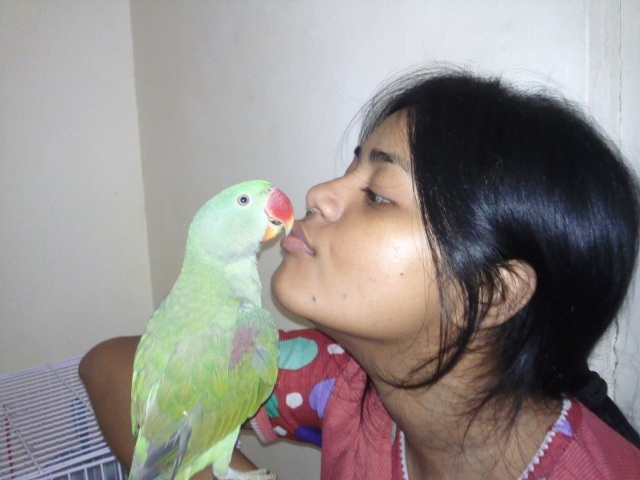 can i give my parrot chole(chana) called in hindi
Question
my little chaddi alexa
dear sir,
can give chan
can i give my parrot chole(chana) called in hindi
Question
my little chaddi alexa
dear sir,
can give chan
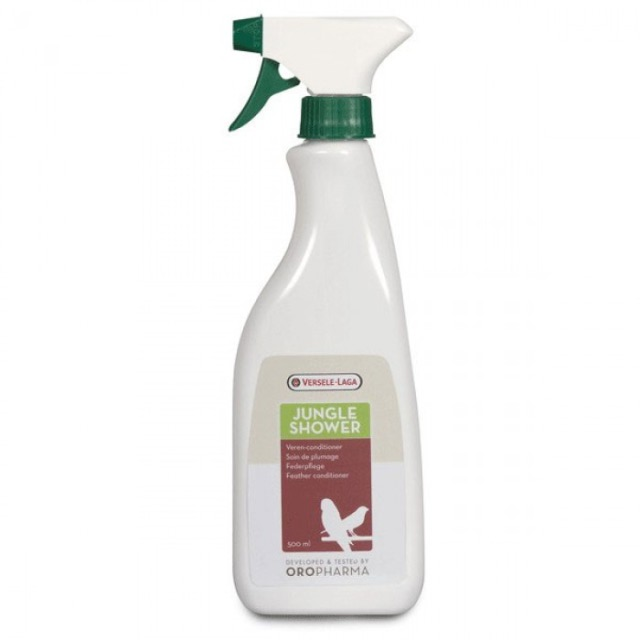 Indian Ringneck Health Issue
QuestionI have an Indian Ringneck who had been neglecte
Indian Ringneck Health Issue
QuestionI have an Indian Ringneck who had been neglecte
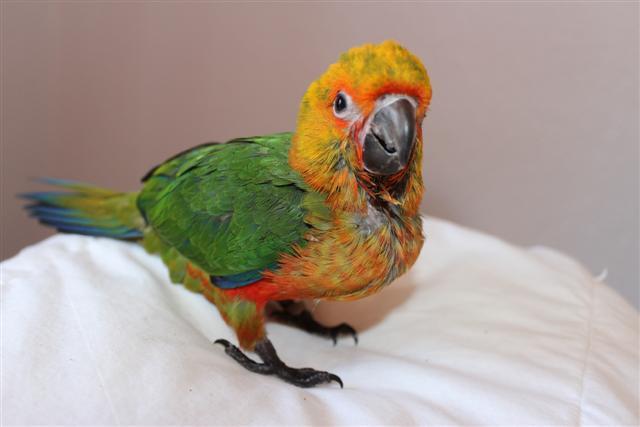 Jenday Conure Weaning?
Question
Castor the Conure
Hi
I have a 9 week o
Jenday Conure Weaning?
Question
Castor the Conure
Hi
I have a 9 week o
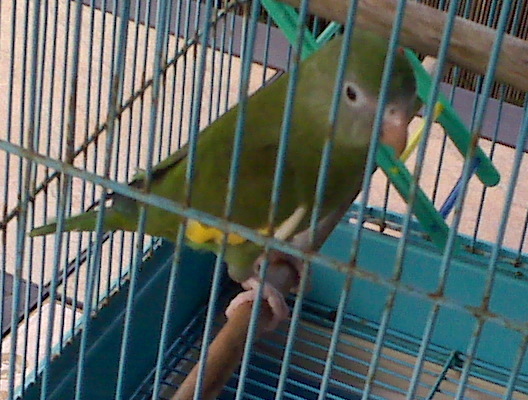 What type of parrot is this?
Question
Friendly bird
A week ago ths small parrot flew
What type of parrot is this?
Question
Friendly bird
A week ago ths small parrot flew
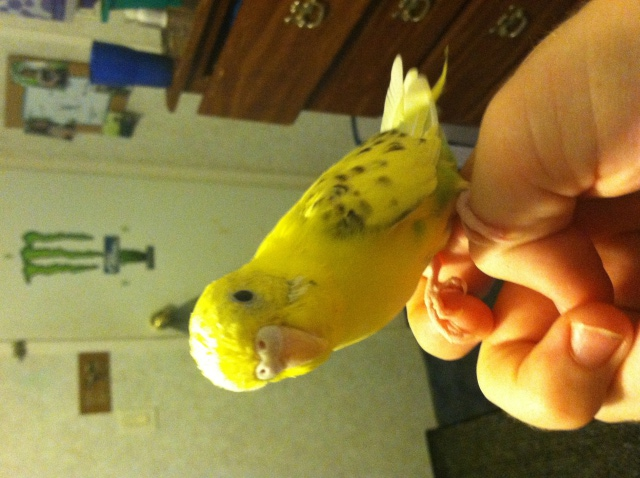 Parakeet gender
Question
Parakeet
Hi, I looked for an expert und
Parakeet gender
Question
Parakeet
Hi, I looked for an expert und